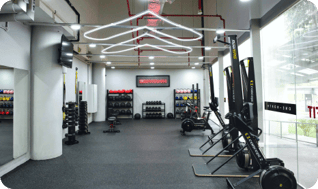Once again in 2025, Singapore’s running community will begin gearing up for months of thrilling events, new milestones, and personal achievements. Whether you’re a novice runner looking to tackle your first run or an experienced racer tackling your personal best, the year will undoubtedly have many exciting opportunities.
But success on any race day doesn’t just happen by circumstance—it requires careful planning, consistent training, and ambitious (but achievable) goal setting. That’s where our 2025 running calendar (click to jump straight to the calendar) update comes into play; this helpful guide will help you earmark important events and forecast what you need to do in preparation for them.
Setting ambitious goals for the new year
Whether it’s breaking into the top 10% of a major race, tackling an ultramarathon, or completing your first 5km run—and everything in between—setting challenging goals gives your training focus and encourages you to push your limits.
At UFIT, we don’t just talk about setting ambitious goals—we live them. One of our trainers, Kieran, inspired us all by running a marathon every day for 150 consecutive days! And several of our team members have proudly represented us at key sporting competitions, such as the Singapore Hyrox.
For active runners eagerly gearing up for a fresh season of running events, the allure of improving upon the previous year’s best times is a shared goal. But what strategies are your peers employing in the pursuit of their best times, and are there any pitfalls you should avoid or improvements you can make to safeguard race-day glory?
Common preparation strategies
If you’re an avid or competitive runner, you likely already have a good understanding of how your body works and how to get into “race shape”. It’s all about getting the basics right and these are some of the core principles that you should already have under your belt.
- Structured training. Whether it’s a 5 or 42-km race, you should know how to put together or confidently follow a training plan that is tailored to your goals. Training plans typically include a mix of speed runs, long runs, and recovery runs, which aim to build endurance and improve your pace.
- Incremental distance increases. Unlike novice runners, who may go too fast too soon, you should have an understanding of progressively increasing volume (time or distance) to give your body time to adapt to the demands of longer races without risking injury.
- Nutritional awareness. You should be mindful of your nutrition and understand that protein is essential for building and maintaining muscle and that carbohydrates are essential to fuel your body’s performance.
- Rest and recovery. Finally, you should know that recovery time is just as important as the time you spend training. This involves taking rest days, getting sufficient sleep, and performing activities that ensure overall well-being.
Potential pitfalls
Even if you’re doing your best to get the basics right, nobody’s perfect, and it’s not always easy to stay on track with everything all of the time. In fact, with so much to think about, it can sometimes be overwhelming, and this is when preparation pitfalls may occur.
- Overtraining. Yes, it's possible to love running too much. A common pitfall is pushing too hard, too soon, or for too long. Overtraining can lead to fatigue, burnout, and a heightened risk of common and potentially severe running injuries, such as iliotibial band (ITB) syndrome, shin splints, or plantar fasciitis.
- Insufficient recovery. Not taking your rest and recovery seriously can significantly hinder performance and increase the likelihood of injuries. Ignoring signs of fatigue and not allowing the body to recover could not only setback your training but also lead to you having to withdraw from the events you’ve trained hard for.
- Not cross-training. We know you love what you do and would like your training plan to consist only of runs and jogs. But, while running should be the backbone of your race-day preparation, you must occasionally take a break from it. Failure to mix up your training and perform other activities could lead to injuries caused by the repetitive impact of running.
- Inadequate nutrition. Proper nutrition can make or break your performance. If you religiously stick to the same diet or head to the local hawker for curry chicken noodles on the eve of race day, then you could be preventing yourself from achieving peak performance.
Elevate your preparation
We want you to be the best version of yourself on race day. So, now that we’ve covered the common preparation strategies and their potential pitfalls, let’s take a look at how you can elevate your preparation to give you the best chance of smashing your best times.
Gradual progression

Instead of diving headfirst into intense training, opt for a gradual progression. Start with manageable intensities and training volumes to build endurance and reduce the risk of injuries.
One strategy is to work up to more competitive races with events that feature more conservative distances. Singapore is already gearing up for an action-packed year of running events in 2025, which offers you a multitude of opportunities to lace up and hit the streets.
Performance fuelling
Knowing how to optimally fuel pre and post-exercise is a game changer; your body needs the right fuel at the right time to deliver the best results.
The two main goals of nutrition before exercise are to optimise glucose availability and glycogen (stored glucose) stores, which will provide the fuel you need to support activity. This can start up to a week before for particularly strenuous events, however, the day before will suffice for most racing events. Focus on consuming complex carbohydrates—beans, whole-grain products, potatoes, etc.—4 to 6 hours before the event.
During exercise, the goal is to provide your body with the essential nutrients it needs to maintain optimal blood glucose levels. As a general rule, an event that lasts less than 1 hour can be adequately fuelled with existing glucose and glycogen stores. However, if an event lasts longer than 1 hour, refuelling with energy gels, liquids, or chews from around the 40-minute mark is advisable.
A normal, healthy diet will facilitate post-exercise recovery within 24–48 hours. However, if the event was particularly strenuous, you may benefit from more strategic nutrition, which can start as soon as 30 minutes after you cross the finish line. This will consist of mostly complex carbohydrates and moderate protein.
If this sounds over-complicated, don’t worry, we have highly qualified and experienced nutritionists who can provide you with a comprehensive nutrition assessment, customised dietary advice, and step-by-step guidance on how to adequately fuel your performance.
Cross-training
Diversify your workouts to prevent monotony and reduce the risk of overuse injuries. Don’t neglect non-running activities that will improve overall fitness and target different muscle groups. The key here is variety, almost every activity is beneficial in one way or another. Here are a few of our favourites:
- Swimming - builds strength and endurance and gives your joints a break.
- Cycling - a low-impact way to build your aerobic and anaerobic performance.
- Yoga/pilates - builds core strength and improves flexibility.
- Strength training - promotes overall muscle development in the upper and lower body and improves any muscle imbalances.

If you’re unsure where to start with cross-training or want to fine-tune your training plan, our personal trainers have a wealth of experience working with both recreational and professional runners. Whether you need a helping hand on your way to your 21-km personal best or require motivation to not skip arm day, we’ve got you covered.
Active recovery
Making rest days work harder for you is a great way to ensure your body safely and strongly adapts to the physical stresses of training. They’re about more than just prioritising sleep, they’re about assessing how you feel and taking action accordingly. This could mean going for a massage, booking a sports physiotherapy appointment, or programming a flexibility routine to give your muscles the care and conditioning they need.
Regular dynamic and static stretching, focusing on the major muscle groups involved in running, will help improve your range of motion and reduce muscle stiffness. Dynamic stretches are best performed before running, whereas static stretches should be done afterwards. Here are some running-specific stretches we love:
- Dynamic - Forward and sideways leg swings.
- Dynamic - Standing hip circles.
- Dynamic - Jog in place, lifting your knees high.
- Dynamic - Standing ankle circles.
- Static - Lying down, pull one foot towards your bum to stretch the quad.
- Static - Standing forward fold, reaching towards your toes to stretch the hamstrings.
- Static - In a kneeling lunge position, lunge forward to stretch the hip flexor.
- Static - Seated on the floor, press your soles together and press down on the legs to stretch the groin.
- Underfuel: Not consuming enough calories undermines both training and race performance, and will have a noticeable impact on your daily energy levels and quality of life!
Adjust the intensity and duration of these stretches based on your comfort level and current condition.
The 2025 running calendar
Singapore’s running calendar for 2025 is already packed with races for all abilities. Here are some of the highlights:
-
18 January. CNY Quby Run. Marina Barrage. 10, 5, or 2 km runs.
-
26 January. MetaSprint Aquathlon. Sentosa. 750 m swim and 5 km run.
-
23 February. MetaSprint Duathlon. F1 Pit Building. 3 km run, 18 km bike, and another 3 km run.
-
28 February. “The Classic” JustRunLah! Virtual Run. 10 and 5 km runs.
-
8–9 March. Singapore Cancer Society Relay for Life. National Stadium. 100 km group run.
-
16 March. MetaSprint Triathlon. East Coast Park. 750 m swim, 18 km bike, and 5 km run.
-
5–6 April. Singapore T100 Duathlon 2025. Marina Bay. Standard Duathlon (42 km) and Long Duathlon (83km).
-
6 April. Singapore T100 Triathlon 2025. Marina Bay. Combined 100 km of swimming, biking, and running.
-
27 April. 2XU Compression Run. F1 Pit Building. 5, 10, or 21 km runs.
-
December. Standard Chartered Singapore Marathon. F1 Pit Building. 5, 10, 21, or 42 km runs.
How many races should you run in a year?
Deciding how many races you’ll commit to in a year is essential for you to maintain peak performance. While the number of runs a body, mind, and schedule can endure will differ greatly from person to person, we suggest:
- Short races (5–10km): Up to 6–8 per year.
- Half-marathons: 2–3 per year. Ensure these are well-spaced out to safeguard recovery and training intervals.
- Marathons: 1–2 per year. These require extensive preparation and recovery time.
You must listen to and observe your body, and, if you have any doubts or concerns, reach out to our team of wellness professionals who are well-versed in massage techniques, sports physiotherapy, and flexibility and mobility programming.


.png?width=301&height=187&name=Website%20Navigation%20Images%20(3).png)

-1.jpg?width=1984&height=1196&name=UFIT%20Club%20Street%20Front%20(4)-1.jpg)





.webp?width=300&name=On%20your%20marks!%20Get%20set%20for%20Running%20Success%20in%20the%20New%20Year%20-%20Blog%20banner%20image%20(1).webp)

